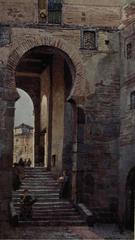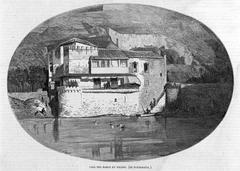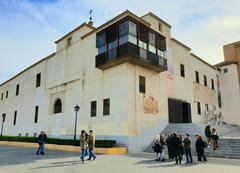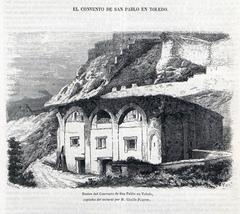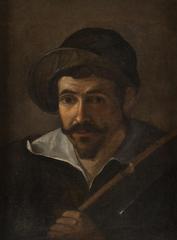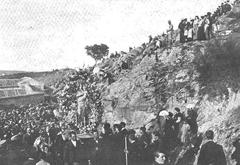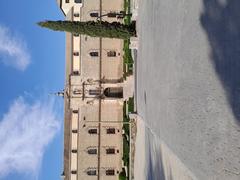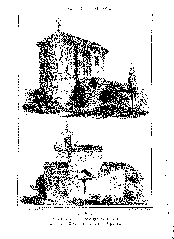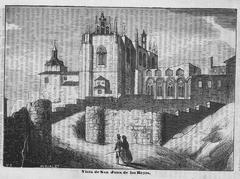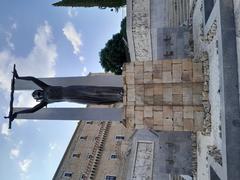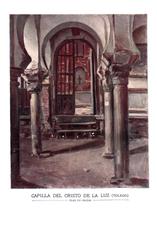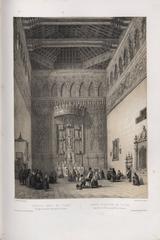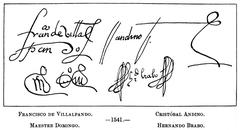
Palacio de Galiana: Visiting Hours, Tickets, and Historical Highlights in Toledo, Spain
Date: 04/07/2025
Introduction: The Palacio de Galiana—A Jewel of Toledo
Perched along the tranquil banks of the Tagus River, the Palacio de Galiana is a captivating testament to Toledo’s layered multicultural heritage and architectural magnificence. Originally constructed in the 11th century as a royal “almunia” or leisure retreat for Al-Mamun, king of the Taifa of Toledo, the palace has evolved across centuries, reflecting the city’s unique blend of Islamic and Christian influences. Today, its Mudéjar arches, intricate tilework, and lush Andalusian gardens invite visitors to step into a narrative where legend, innovation, and artistry converge (Palacio de Galiana Official Website; Toledo Tourism).
This guide provides a comprehensive overview for anyone planning to visit the Palacio de Galiana. From historical context and architectural features to practical visitor information and nearby attractions, you’ll find everything you need for an insightful and memorable experience in one of Toledo’s most treasured sites (Toledo Turismo).
Historical Overview
Origins and Early History
Commissioned by Al-Mamun in the 11th century, the palace was designed as an “almunia”—a royal rural estate set among fertile gardens and orchards. Its innovative water systems, including a celebrated water clock by Al-Zarqali (Azarquiel), and botanical collections curated by Ibn al-Wafid, established it as a center of science and horticultural experimentation (Wikipedia; Triphobo).
Medieval Transformations and the Reconquista
The palace’s fortunes shifted during the Christian reconquest of Toledo in 1085. Alfonso VI used the estate as a strategic base, and subsequent military campaigns led to significant damage. Major Mudéjar-style reconstructions in the 13th century gave the palace much of its present architectural character (Toledo Spain; Official Website).
Ownership Changes and Modern Restoration
Throughout the late medieval and early modern periods, the palace changed hands among noble families and religious institutions, with further Mudéjar renovations marking each era (Arteguias). In the 19th and 20th centuries, restoration efforts—particularly those led by Carmen Marañón and architect Fernando Chueca Goitia—rescued the palace from decline, preserving its Mudéjar features and historic gardens (Official Website).
Architectural and Artistic Highlights
Mudéjar Splendor and Moorish Roots
The Palacio de Galiana is a prime example of Mudéjar architecture—a blend of Islamic and Christian artistic traditions unique to medieval Spain. Its rectangular floor plan encompasses nine vaulted halls surrounding a sunken courtyard with a reflecting pool. Hallmarks include horseshoe arches, glazed ceramic tilework (azulejos), ornate plasterwork (yesería), and coffered wooden ceilings (artesonado) (Toledo Turismo; Arteguias).
Gardens and Hydraulics
The palace gardens, restored in the tradition of Islamic paradise gardens, feature geometric beds, fountains, and irrigation channels that descend in terraces toward the river. Plantings of cypress, myrtle, and fruit trees evoke the botanical sophistication of al-Andalus (Jardines Históricos de España).
Decorative Features
- Tilework: Richly glazed azulejos in blues, greens, and ochres.
- Plasterwork: Intricate arabesques and vegetal motifs.
- Woodwork: Exquisite artesonado ceilings for both decoration and acoustics.
- Water Features: Pools and channels symbolizing paradise and technological ingenuity.
Conservation and Modern Use
Restoration in the mid-20th century stabilized the palace and gardens, while ongoing conservation addresses challenges from humidity and urban encroachment (El País; ICOMOS España). The palace is now a listed Monument of Cultural Interest and serves as a venue for exhibitions, events, and film productions (Official Website).
Visitor Information
Opening Hours and Tickets
- Opening Hours: Generally open Tuesday to Sunday, 10:00 AM to 6:00 PM. Closed Mondays and public holidays. Always consult the official website for seasonal changes or special closures.
- Tickets: Standard admission is €8 for adults, €5 for students and seniors, and free for children under 12. All visits must be booked online in advance (Palacio de Galiana Tickets).
- Guided Tours: Self-guided audio tours are available in multiple languages. Guided group tours can be arranged for an additional fee; advance booking is recommended.
Accessibility and Facilities
- Accessibility: The gardens and ground floor are generally accessible, but some areas may have uneven ground or steps. Contact the site in advance for specific needs.
- Facilities: Restrooms are available. There is no on-site café, so plan meals in advance.
- Photography: Permitted in most areas; flash and tripods may be restricted.
Getting There
- By Car: Parking is available nearby; use GPS for “Palacio de Galiana, Toledo.”
- By Taxi: Taxis from central Toledo are convenient.
- Public Transport: Limited bus service is available; check current timetables.
Visitor Tips
- Audio Guide: Download the official guide before arrival for enhanced context.
- Best Time to Visit: Mornings are recommended, especially in summer.
- Combine Visits: The palace is close to other Toledo highlights like the Parador de Toledo, Mirador del Valle, and the historic city center (hotelmix.co.uk; civitatis.com).
Legends, Culture, and Literary Lore
The Palacio de Galiana is steeped in legend, most famously the story of Princess Galiana, whose fabled romance with Charlemagne symbolizes the cross-cultural exchanges of medieval Spain (Historias de Toledo; Toledo Legends). The palace has inspired poets, historians, and artists since the Middle Ages, and today its ambiance continues to attract cultural events, photo shoots, and media features (milieumag.pdf; Reportaje_Hola_Palacio_de_Galiana.pdf).
Frequently Asked Questions (FAQ)
Q: What are the Palacio de Galiana’s visiting hours?
A: Open Tuesday to Sunday, 10:00 AM to 6:00 PM; closed on Mondays and public holidays. Always check the official website for updates.
Q: How much are tickets?
A: €8 for adults, €5 for students and seniors, free for children under 12. Tickets must be booked online in advance (Palacio de Galiana Tickets).
Q: Are guided tours available?
A: Yes, guided tours and audio guides are available. Guided tours should be booked in advance.
Q: Is the palace accessible for visitors with disabilities?
A: The grounds are partially accessible. Contact the palace for specific accommodations.
Q: Can I take photographs?
A: Yes, for personal use. Professional photography requires permission.
Q: Is there parking?
A: Yes, parking is available nearby.
Visual Gallery
Plan Your Visit and Explore More
Toledo’s Palacio de Galiana stands as both a monument to the city’s cosmopolitan past and a living cultural landscape. Its proximity to major sites like the Alcázar, Cathedral, and Jewish Quarter makes it an essential stop for anyone seeking to experience Toledo’s historical depth and architectural beauty. Enhance your visit with the official audio guide or the Audiala app for interactive tours and the latest updates.
Related Reading
Sources
- Palacio de Galiana Official Website
- Toledo Tourism: Palacio de Galiana
- Toledo Turismo: Palacio de Galiana
- Arteguias: Palacio de Galiana
- Med-O-Med: The Galiana Palace
- Palacio de Galiana Tickets and Visitor Info
- Historias de Toledo
- Toledo Legends
- Milieu Magazine Feature (PDF)
- Revista Hola Feature (PDF)
- Jardines Históricos de España
- El País
- ICOMOS España
- Civitatis: Toledo
- Hotelmix.co.uk






